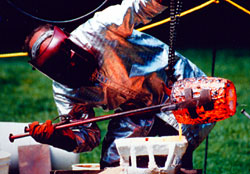The Movement of Bronze: Andrew DeVries
 Venus Torso, by Andrew DeVries
Venus Torso, by Andrew DeVriesCourtesy of Andrew DeVries
Andrew DeVries makes bronze sculptures of dancers. He makes the bronze dance, too.
Everywhere there is motion, and energy. It's there in the moments frozen in time in the dancers' poses; poses that are never entirely static, never fully in equilibrium. Instead, they seem to be forever going somewhere in a timeless choreography that implies its past and future yet offers only its immediate present as a certainty.
A kindred motion and energy are also evident in the surfaces of the bronze itself, where the artist shapes the metal's surfaces not to render the forms more realistic but to make them more expressionistic and more impassioned.
As a result, DeVries' art is as much about abstraction as it is about realism. As the two function together in the same work of art, they serve and add to each other, making each stronger and the combination in the finished work stronger yet.
DeVries produces his work in sizes ranging from as small as nine inches high to as large as 50 inches, with a few works considerably larger. Like most bronze sculptors, the vast majority of his pieces are produced in limited editions. For the smaller works, the edition size ranges from as few as 30 to as many as 100 works. The larger sculptures are produced in smaller editions, usually ranging between eight and 12 pieces.
By far the largest pieces to come from DeVries studio are his commissioned sculptures. In nearly all cases, these are scaled up versions of smaller works. An early example of this type is 1989's " Dance of the Morning," which recreates a small bronze originally produced two years earlier. Destined for an outdoor location at the Hebrew Home hospital in Hartford, Connecticut, the nine-foot tall sculpture's dancing figure exalts the vitality that powers and celebrates life. You can see and feel this power in the roughly modeled forms of the figure's bronze musculature, and in the unstable pose which makes the figure appear to extend itself outside of the restraints of its base and thereby to engage with the wider world beyond.
"Dance of the Morning," which was cast in seven sections welded together, also reveals what the artist refers to as his "intuitive engineering" which allows him to successfully construct the sculpture in spite of the fact that much of its weight is diagonally off-center relative to the single foot which links the dancer to its foundation. He achieves these results by adjusting the thickness of the work's bronze walls at various points, so that they're thicker where they bear more weight and thinner where less structural strength is required.
 Sculptor Andrew DeVries at work
Sculptor Andrew DeVries at work Courtesy of Andrew DeVries
DeVries success and exploitation of bronze's structural possibilities remains a constant throughout his work. An especially fascinating example is his very recent "Innocence." In this 2009 creation, a life size nude female figure floats horizontally in the air nearly six feet above its base, supported only by the generous flowing tresses of her hair. The work has the undeniable feel of magic and mythology. It's DeVries' mastery of bronze that makes this magic possible.
Largely self taught, DeVries came to his approach to sculpture and art making through two major influences. The first was his experience repairing heavy machinery used on the farm his family owns near Rochester, New York. The experience gave him his first tastes of working with metals and sparked an intense determination to be an artist; more specifically, to be a sculptor.
Having set this goal for himself, he dropped out of high school and set off on a journey across the United States that soon would take him to his next point of significant destiny - a ballet studio in Denver, Colorado. There, over the course of a couple of years, he would spend nearly every day producing pencil and charcoal drawings of every detail and nuance of the dancers' poses and movements. Simultaneously he started working with clay, the material with which almost all bronze sculpture begins. All of the work that DeVries has since produced emerges from these beginnings on the farm and at the dance studio.
visitors to DeVries site can view a wide array of his bronze sculpture spanning more than two decades, learn more about the artist's unique personal story, and take a virtual tour of the extensive studio facility he built for himself in the Berkshire hills of western Massachusetts. You'll see him dancing with bronze, and dancing with life, in everything he touches.
"It is the artist's duty to stretch the boundaries of our day-to-day experiences and go beyond them to a deeper understanding of ourselves," adds DeVries.
Resources:
Also in this Issue:
- Schtiller & Plevy: A Commitment to Restoring History
- Gregory Nangle: Outcast Studios
- The Movement of Bronze: Andrew DeVries
- Capturing the Wild West Through Bronze
- MET Features Work of Renowned 19th-Century American Sculptor and Metalist Augustus Saint-Gaudens
